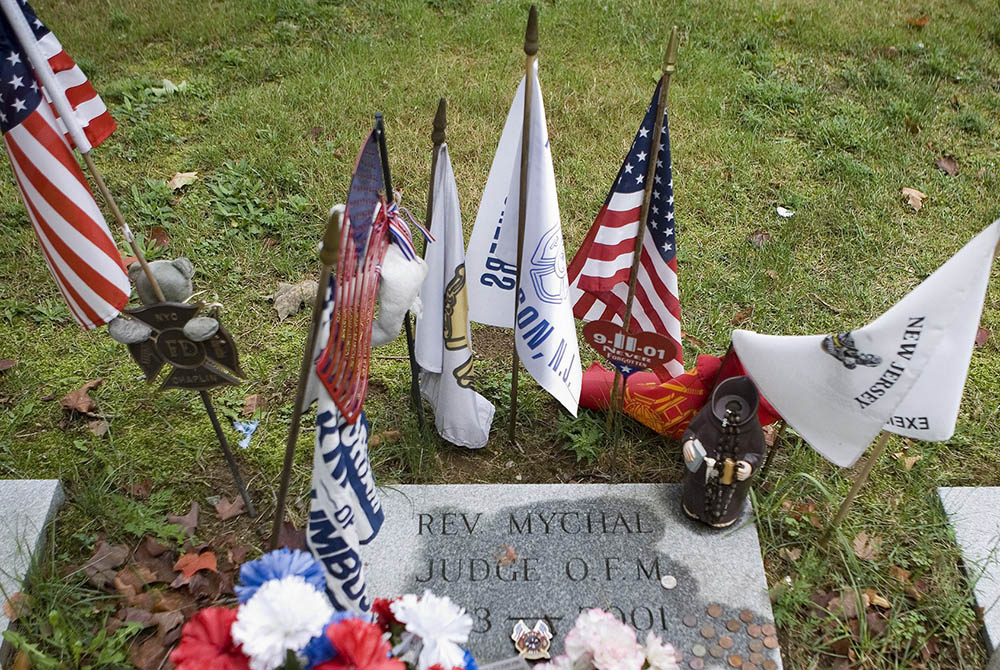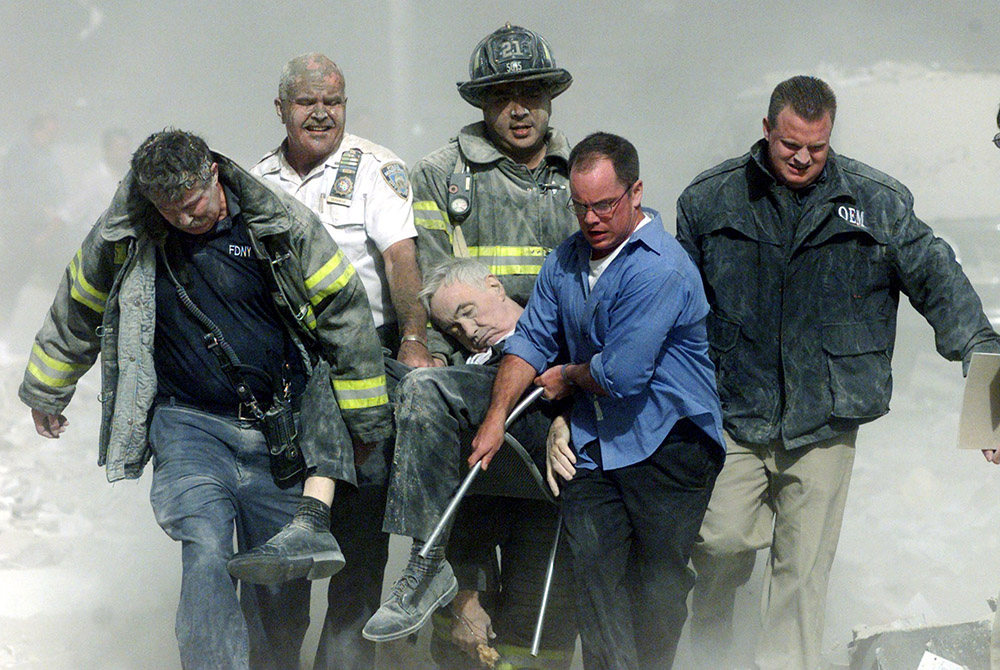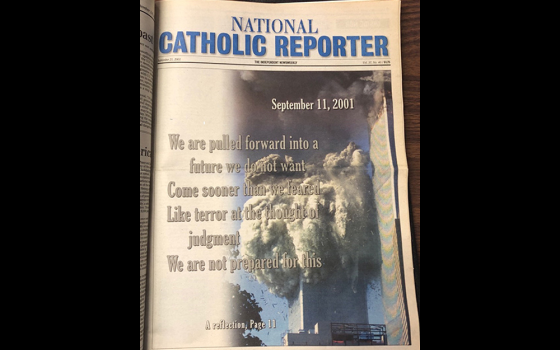
Flags and other items surround the grave where Franciscan Father Mychal F. Judge, a chaplain of the New York Fire Department, is buried at Holy Sepulchre Cemetery in Totowa, New Jersey. Judge died in the Sept. 11, 2001, World Trade Center attacks. (CNS/Octavio Duran)
As fate would have it, photographer Richard Drew, just 21 years old at the time, would be one of four press photographers present when Robert F. Kennedy was shot at the Ambassador Hotel on June 5, 1968. Close enough that Kennedy's blood splattered across the lapels of his jacket, Drew raised his camera in time to snap one of American history's most iconic images: Kennedy, felled by the bullets of a .22 revolver.
On the morning of Sept. 11, 2001, Drew was, once again, photographing bodies.
As part of a maternity fashion show that day, Drew was photographing pregnant women in New York City's Bryant Park. While on location, he got a call from his office telling him that a plane had struck the World Trade Center. Quickly gathering his things, he hopped on a subway car heading downtown, the only occupant on the train. Exiting at Chambers Street, he turned west. By then both towers of the World Trade Center were billowing smoke. Standing between a police officer and an emergency technician he stopped, tilted his camera to the sky and pressed the shutter.
Drew, a photographer with The Associated Press, reviewed the photo later on his laptop back at his office, as he told CBS News recently. The next morning, it appeared on Page 7 of The New York Times, and subsequently, in hundreds of newspapers all over the world. The man inside the frame, the "Falling Man" as he was called, was not identified.
The decision to leap from the burning building ensured the death of this anonymous victim. But the sleek silhouette cast by the "Falling Man" provoked an additional level of distress. His streamlined, headfirst descent, sliced through the air with a troubling efficiency. He had resigned to his fate, neither flailing nor struggling. Plummeting toward the ground like a missile, he made his way from falling to fallen.
Bookending this image is another unforgettable snapshot from that surreal day: the lifeless body of Fr. Mychal Judge.

New York firefighters and rescue workers are seen Sept. 11, 2001, carrying Franciscan Fr. Mychal Judge, a chaplain with the New York Fire Department, who died while giving last rites to a firefighter in the aftermath of the terrorist attacks that brought down the twin towers of the World Trade Center. Sept. 11 this year marks the 20th anniversary of the attacks that claimed the lives of nearly 3,000 people in New York City and Shanksville, Pennsylvania, and at the Pentagon. (CNS/Reuters/Shannon Stapleton)
Mychal served as a chaplain to the New York City Fire Department, in addition to belonging to a community of Franciscans with whom I had come to know and love. Impish and gregarious, he left few immune to his magnetic charism. With quintessential Irish swagger, his mere presence filled every room he entered. He was the very definition of larger than life.
That morning, as word spread of the explosions, he rushed to the scene, eager to support his NYFD congregation. After learning people were trapped in the wreckage, Mychal made a beeline for the north tower. Mychal was killed during the collapse of the south tower and subsequently classified as "Victim 0001," a fateful first in a day mired in tragedy.
The photograph of the retrieval of Mychal's body also made it into The New York Times. Carried out by the very men he served, this image is akin to a modern-day Pietà. A corpse cradled tenderly in the arms of those who loved him.
It's been 20 years since the towers fell. Twenty years since the walls of the Pentagon shook. Twenty years since a handful of courageous souls wrestled an airplane to the ground in the fields of Pennsylvania.
Advertisement
But despite the passage of time, Sept. 11 lives on in our collective memory. It's as if the clocks stopped that day, holding us eternally captive to that moment of horror. And yet time does move forward. No matter what we do, we can't stop it. The metronome of life continues on.
Even broken hearts keep beating.

Franciscan Fr. Mychal Judge, a chaplain with the New York Fire Department, is pictured in an undated photo wearing his helmet and bunker coat. (CNS/Courtesy of Holy Name Province Franciscans)
So, let us mourn the dead. Let us grieve our loss. But let us also remember, on that same day, heroes were born. Ordinary men and women, just like those who frantically rushed into the towers to try and save Mychal, emerged as shining examples of bravery and grace. They put themselves at risk for one reason and one reason only — someone else. A blessing never to be forgotten.
The north and south towers of the former World Trade Center have become a cathedral in absentia for Americans living in a post 9/11 landscape, a palpable ghost of what once was. While One World Trade Center now gleams in their stead, a rebuilding of notable measure, the repair is still not complete. A suspicion and division, rooted in religious, cultural and political differences, still remains. Sadly so.
Nonetheless, that work can be left for another day. This week is for remembering.
When I think of Mychal now, I am reminded that his sacrifice was rooted in his Christian vocation. He remains a beacon for all of us not only for his heroism, not only for his instinctual response, but for the faith that inspired him. He was a priest until the very end.
So, as we approach the 20th anniversary, we hold in our hearts the memories of all those whose lives were lost, whose innocence was taken or whose existence was forever changed at 7:59 a.m. when American Airlines Flight 11, bound for Los Angeles, lifted off the runway of Boston's Logan International Airport.






